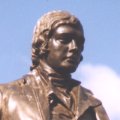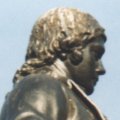|
 |
|
| |
 |
|  |
|
Details:
|
|
|
Sculptor:
George Edwin Ewing
(1828-1884)
Bronze reliefs by
James Alexander Ewing
(1843-1900)
Materials: Bronze statue and reliefs on granite pedestal
Foundry: Cox & Son, Thames Ditton
Pedestal: Meldrum Brothers, Dumfries
Location: George Square, Glasgow
Date executed: 1873-7. Bronze reliefs 1885-7
Statue unveiled: 25 January 1877
|
|

|
Glasgow's monument to Scotland's national poet, Robert Burns, was erected by public
subscription after a suggestion by William Wilson, a Glasgow merchant and magistrate, who came up wth
the idea in 1872. It is a bronze statue standing on a granite pedestal, and was the work of the most
successful sculptor of his generation in Scotland,
George Edwin Ewing
, his commission for the statue
being given in 1873.
Costing £2,000, it took almost four years to complete, being cast in
October 1876 at the foundry of Cox & Son of Thames Ditton, who remarked that their casting had been "one of
the most perfect they had ever produced". The statue was unveiled on the anniversary of the poet's
birth a few months later on 25 January 1877, by Lord Houghton, an author and biographer of Keats,
amidst a crowd of 30,000 spectators, a public holiday having been declared for the occasion.
|



|
Ewing's likeness of Burns' face was inspired by the portrait by Alexander Nasmyth, of 1787, and
the chalk drawing by Archibald Skirving, of 1796-8 (both of which are in the SNPG
), whilst the
statue's pose was intended to convey 'the idea of the poet in the circumstances of his daily life'
and represent him as a 'superior Scottish peasant', holding his '...broad Kilmarnock bonnet half
crushed in the hollow of his right elbow, and holding the 'wee crimson-tipped flower' in his [left]
hand...'.
Robert Burns (1759-96) was born in Alloway, Ayrshire, the son of an impoverished farmer. He began
writing poetry in 1783, and initially sought to publish his work in Glasgow. After his manuscripts were
rejected by the city's publishers, he published his first volume of poetry, Poems, Chiefly in the
Scottish Dialect, in Kilmarnock (known as the Kilmarnock Edition), in 1786.
|


|
Threafter, he published scores of poems, songs and satires on amorous, political and narrative themes,
the latter including Tam O' Shanter, and collected folk tunes to which he added new lyrics, such as
Auld Lang Syne, The Banks O' Doon, Scots Wha Hae and A Red, Red Rose, all of
which are recited and sung around the world, particularly at Burns suppers on the anniversary of his
birth, from Mossgiel to Moscow and Tarbolton to Tokyo.
Scenes from some of his best known poems are illustrated in the three figurative bronze reliefs on the
statue's pedestal: (left side) the cottage interior from The Cottar's Saturday Night; (right side)
the grisly revelries at Alloway Kirk from Tam O' Shanter; and (rear) the poet being crowned
in The Vision. The panel on the front of the pedestal bears the dedicatory inscription: ROBERT
BURNS / BORN 1759 / DIED 1796.
|




|
The figurative panels were produced by
James Alexander Ewing
, the younger brother of the statue's sculptor,
in 1887, and gifted by the towns of Ayr, Kilmarnock, Paisley, Cumnock and Irvine, all of which had strong
connections with the poet. The plaster models for the panels are on display in Burns' Cottage at Alloway.
Burns was lauded in Edinburgh society and by the leaders of the Scottish Enlightenment from the outset of his
literary career, but despite the fame that his work earned him, he lived the rest of his life in poverty in
Ayrshire, working as a farmer and excise man. He died on 21 July 1796 at his home in Dumfries, leaving his wife,
lovers and children to mourn their loss and his friends and admirers to create a legend.
|




|
Since then, more public statues and memorials have been erected to Burns than any other poet before or since,
with at least fifteen statues in Scotland, twenty two in North America, and the rest located wherever immigrant Scots settled
throughout the Commonwealth. His statue in George Square is one of the the most successful artistically, with Ewing's
determination that it should be 'the most complete of Burns in existence' being fully realized in its execution and
in its embodiment of the 'easy and graceful attitude of poetic contemplation' that became the ideal expression for later
sculptors of Burns statues.
*****************************************
See also our January, 2002 Newsletter page on Glasgow's other Burns sculptures (Inside Story: Robert Burns in Glasgow)
And the Homecoming Scotland 2009 festival.
|
|
Click on an image to enlarge it.
|
Click here to return to the TOP.
|
|
|
All images and biographies are our copyright and may not be reproduced
in any form whatsoever without our express permission.
|
|
|
|
|
For sculpture and architecture: we have over 300 biographies of sculptors and architects connected with Glasgow, Scotland.
|
|
| Copyright 2001-2026 glasgowsculpture.com. |
|
|
| |
|
 |
|

